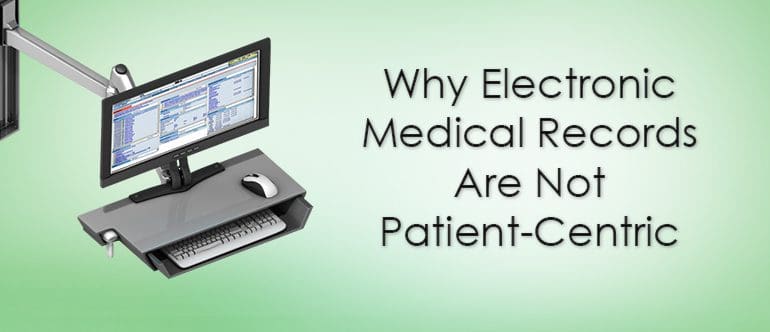Call us toll-free: 800-878-7828 — Monday - Friday — 8AM - 5PM EST

By Laurence Chu, MD, FACS for Forbes
Current information technology is lacking an efficient and comprehensive solution to everyday care for the healthcare provider and patient. For many physicians, there is a forced acceptance of the electronic medical record (EMR). Providers have choices from EMR vendors like athenahealth, Cerner CERN, eClinicalWorks, Epic , General Electric’s GE Healthcare and many others. But there is a general lack of satisfaction with the EMR by providers. I was once told that MD really stood for “Make Do” with what you have. That is certainly what I have had to do with the electronic record. Patients see the physician-patient relationship transform, with a computer that takes time away from the patient. This results in a skewed patient encounter causing more time to be spent entering extraneous data than having direct patient interaction.
The mainstay of healthcare IT appears to be focused on the need for regulatory and insurance requirement satisfaction of Meaningful Use, but not for ease of use. After all, when these requirements are met, you get paid. Large institutions are using a complex database that manages work force, supplies and infrastructure, and only a small part of this is the EMR. From a physician’s perspective, my perspective, I need to see specific bits of information correlated with a verbal history from the patient. Each patient is unique, and requires individual attention. The growing use of protocols to direct patient care is concerning in cases of atypical illness presentation that is not well captured by this methodology. Each physician looks at clinical information uniquely and draws a clinical picture. Medical decision making is deductive reasoning influenced by available information. When a history becomes electronic, taken by an assistant or checklist, the distillation of information may miss important clues. Taking an accurate medical history requires skill and time. Inflection of the voice, hand gestures, eye contact, flow of the conversation are lost in a checklist. Straightforward data—lab studies, imaging, pathology and other doctor’s notes— can be collated but can lack usability. Flipping screenshots of labs, medical notes, imaging (x-rays and such) and going back and forth is inefficient. Sometimes, I need to print out everything to see the information side by side and glean out what I need.
The special relationship between patient and physician is further diminished by inefficient data entry with cumbersome interfaces. To meet the “meaningful use” criteria, there is excessive and time consuming data entry that lends little to the encounter. Many practices employ scribes. This person takes the verbal commentary from the physician and enters the data to the EMR. Clearly not very cost effective nor efficient when another employee is needed to see the same number of patients before the EMR was used. I do not employ a scribe but spend my time with the patient. I will jot a few notes, send an electronic prescription and review available medical data. The actual note will be finished after the patient leaves. This is not efficient either. I have very positive feedback from patients, but I see fewer patients.
Electronic prescribing has helped with safety and speeds submission of prescribed medications, but custom compounding and special orders are an electronic exception. I use a special formulation for mouth sores that requires custom compounding and requires a custom input prescription that isn’t recognized by the EMR in a contextual way. So, it is not really cataloged by the EMR in a “useful” manner. Recently electronic prescribing of controlled substances (EPCS) has been introduced and, so far, is an efficient way to prescribe these medications, even with encrypted prescriber verification. One question no one can answer is how to recall an incorrect prescription. Sometimes the software auto enters a dose or concentration in a field and when submitted has conflicting information. For example amoxicillin has several strengths and the E-prescription will fill the strength by the drug name which cannot be altered, but it has a subfield for strength that is selected from a pull down list. This results in conflicting information. I cannot “recall” the prescription but must send a new one.
For me, the limitations of the EMRs that I have seen are a disconnect between the regulatory requirements and the need to have medically meaningful communication while maintaining the personal relationship that so many patients want. There is even a parody of this presented by ZDoggMD. The sheer number of clicks of the mouse, pages to go through for a single patient encounter would anger users if they were forced to use this software for their work. I would like to see the developers of the business layers to the EMRs change their paradigm. Allow on-the-fly changes, have a personalized dynamic display of medical information achievable with only a few mouse clicks.
I think the origin of the new software will be cross-industry. Since medicine is a complex service industry, I can foresee something like the cruise industry or hotel and hospitality to expand into healthcare. Isn’t the visit to the doctor like checking into the hotel? Need a credit card, form of ID, and voila, you are checked in. Going to the concierge floor? They already know what you like from your last visit. Calculations of food, drink, towels used, etc. could be translated to the medical office use of supplies and medications. Healthcare aspects of medications, interactions, collection of vital signs, lab work, are all data points for the database. Yes, there are regulations and special circumstances, but what we have now, just isn’t working. Once the interface is realized for this industry, the software will help and not hinder the daily workflow. I realize there is not a simple answer, but I am hopeful that there is more collaboration with doctors and software developers.
